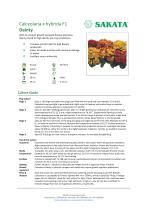 Website:
SAKATA ORNAMENTALS EUROPE A/S
Website:
SAKATA ORNAMENTALS EUROPE A/S
Catalog excerpts

Calceolaria x hybrida F1 Dainty With its compact growth and good disease tolerance, Dainty is bred for high density pot crop production. Compact growth habit for high density production Easier to handle and ship with minimum damage to leaves Excellent series uniformity Culture Guide Plug Culture Stage 1 (days 1-10) Single sow pellet into plug trays filled with fine peat and a pH between 5.5 and 6.0. Calceolaria requires light to germinate but a light cover of medium vermiculite helps to maintain optimum humidity. Maintain a temperature of 18-20°C. Stage 2 (days 11-20) After seedlings germinate, place in a bright greenhouse with good air movement and a day temperature of 21-22°C and a night temperature of 18-20°C. Supplemental lighting can help hasten development under low light periods. If no starter charge is present in the media, a light feed of 75-100 ppm Nitrogen from a well-balanced calcium nitrate based fertilizer is recommended. Stage 3 (days 21-34) The true leaves are forming and plugs are beginning to fill in the cells. Maintain the pH at 6.2 or lower to avoid iron chlorosis. Maintain the temperature between 18-22°C to avoid premature flower initiation. Calceolaria is sensitive to sunscald at all production phases so avoid light intensities above 54,000 lux. Allow the media to dry slightly between irrigations. Fertilize as needed to maintain the EC at 1.0 to 1.6 mmhos (1:2 slurry). Stage 4 (day 35) The plugs are now ready to transplant into pots. Do not delay transplanting. Media Temperature Fertilizer Lighting Growth regulators Pests & diseases Calceolaria will stretch and deteriorate quickly if held in dark and/or warm temperature conditions. Night temperature is the major factor that influences flower initiation. Flower bud initiation occurs when the plants have 3-4 pairs of true leaves and the night temperature between is 11-14°C. Transplant into pots using a rich, well-drained compost. A pH of 5.5 to 6.0 will give the best results. Establish at 18-22°C then lower the temperature to 12°C for 5-6 weeks to initiate flower buds, then raise the temperature to 15-17°C for finishing. Fertilize as needed with 75-100 ppm N using a well-balanced calcium nitrate-based formulation and maintain the EC at 1.0 to 1.8 mmhos (1:2 slurry). Flower initiation: Calceolaria is basically day-length neutral in regard to flower initiation. Calceolaria Dainty is naturally compact and should not require growth regulator applications. Root and crown rots. Avoid overhead excessive watering around flowering to prevent Botrytis. Calceolaria is susceptible to Tomato Spotted Wilt Virus (TSWV), which is spread by Thrips. If foliage begins to turn chlorotic, check the root system for signs of poor development that could have been caused by overwatering, root rots or high salt levels. A high or a low pH can also contribute to chlorotic foliage from iron or magnesium deficiency, respectively. Sakata Ornamentals Europe Odensevej 82, 5290 Marslev, Denmark, +45 63906490, fax. +45 63906499 marcom@sakata.eu, www.sakataornamentals.eu
Open the catalog to page 1
All information given is intended for general guidance only and is believed to be accurate. Cultural details are based on Northern Hemisphere conditions and Sakata cannot be held responsible for any crop damage related to the information given herein. Application of recommended growth regulators and chemicals are subject to local legislations and manufacturer's label instructions. Sakata Ornamentals Europe Odensevej 82, 5290 Marslev, Denmark, +45 63906490, fax. +45 63906499 marcom@sakata.eu, www.sakataornamentals.eu
Open the catalog to page 2All SAKATA ORNAMENTALS EUROPE A/S catalogs and technical brochures
-
FLOWER CATALOGUE Cuttings
13 Pages
-
FLOWER CATALOGUE Seeds
120 Pages
-
MAGIC CARPET Mecardonia
2 Pages
-
BEAUTICAL x Petchoa hybrida
1 Pages
-
ADMIRAL Antirrhinum majus F1
2 Pages
-
GRACE Clarkia amoena nana F1
2 Pages
-
CONDOR Brassica oleracea F1
2 Pages
-
CANDLE Delphinium elatum F1
2 Pages
-
HARMONY Anemone coronaria F1
2 Pages
-
Flower Catalogue 2017 CUTTINGS
32 Pages
-
Flower Catalogue 2017-2018 SEED
59 Pages












